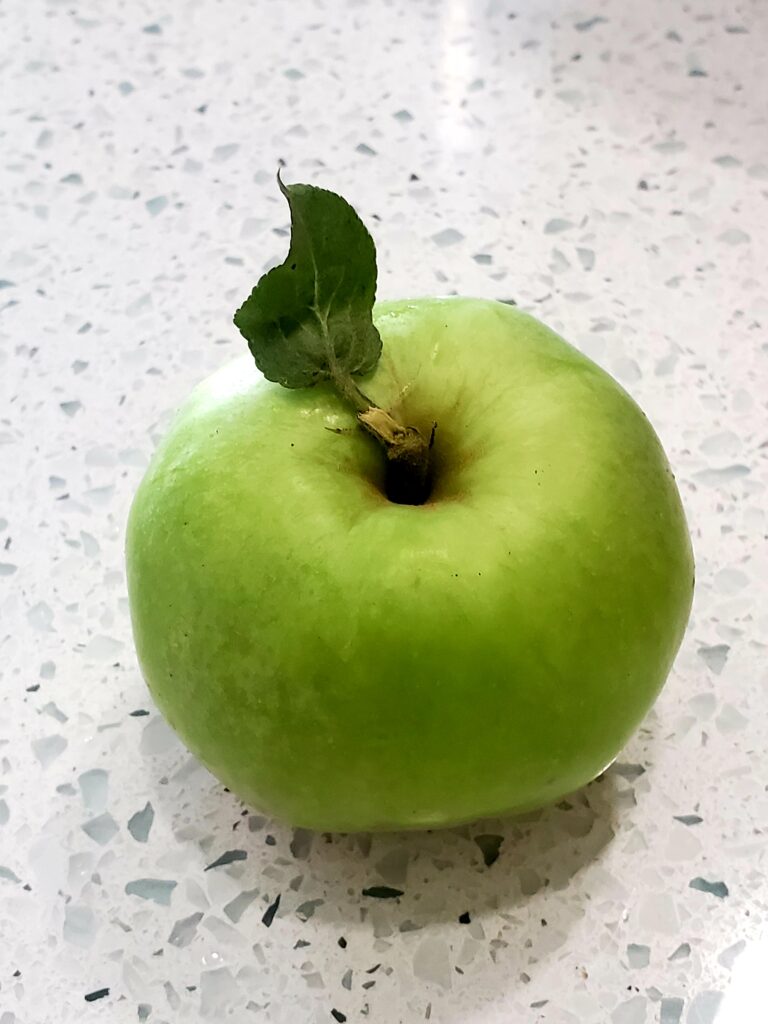There is a wonderful satisfaction that I feel when I can make meals with food grown in my own yard. Even more satisfying is enjoying the bounty with little effort to produce it. That is definitely the case with the apple tree in my backyard. Year after year, it grows delicious apples that are perfect for eating fresh, cooking, and juicing for cider. It was a small tree of a few years old when I bought our home nearly 25 years ago. Today it is about 10 feet high by 10 ft wide. So, it is very manageable to harvest the fruit I need for my kitchen creations. Most of the fruit hangs low within easy reach to pick fresh. These are organic as I never spray. There are plenty of apples to have enough for our needs and share with the birds, bunnies, squirrels, and insects that feed on them too.

It is an early producing Jonathan variety of apple. The flesh is firm and sweet, with a wonderful tartness that comes through in the apple pie recipe (link below). The skin of the fruit is a pale green that gets a red blush when the fruit is fully mature at the end of its season. Apples are ready for harvesting on our tree from mid-July to mid-September. We live in the suburbs of Seattle in the Northwest well known for its ideal climate for growing apples. In fact, Washington State is the top producer of apples in the United States growing an average of 128 million bushels of apples per year according to the Washington Apple Commission.
This year I took full advantage of the bounty from our tree. These were scrumptious to eat fresh off the tree when green and the perfume of the apples began to fill the air in its vicinity when first ready to pick in July. This was also the time to bake a homemade apple pie. A perfect summer treat with a scoop of vanilla ice cream. In addition to a lovely pie, we enjoyed many weeks of fresh apples. At the end of August, I picked the remaining apples the animals left hanging on the tree for us. I processed them with my juicer and made applesauce and pressed juice. The juice was delightful, but I saved most of the juice to make an effervescent hard apple cider that is currently fermenting in a 5-gallon glass carboy in a cool space in our home. It will be wonderful to drink this fall.
This is a simple recipe. It is not exact in measurement, but easy to follow. If you have a little more or less juice it should be fine. I added 4 and a half gallons of juice to a well cleaned 5-gallon carboy and 1 packet of Red Star Côtes des Blanc dry wine yeast. This yeast is easy to find for purchase online or at your local brewer’s supply shop (link below). If you do not have enough freshly pressed juice, you can always add juice from the store. Just make sure that your juice is free of preservatives like potassium sulfate or sodium benzoate, as this will kill the yeast. Citric Acid or added water in the juice is OK, but it is best if you can find 100% juice. The carboy is topped with a 3-Piece Airlock and needs to sit to ferment in a cool dry place, ideally between 60 to 70 degrees Fahrenheit. (Brewer’s set link below) Fermentation in the carboy will take about 2 weeks. Then you can bottle it into smaller containers. If you want your cider to be sparkling add a teaspoon of sugar to your bottles when bottling and let sit for another 2 weeks. Then it will be ready to enjoy. Check out our shop for links to purchase brewing supplies to make your own hard cider.
The Jonathan apple variety is a self-pollinating tree. So, if you have the room in your yard you just need one tree to produce the bounty we enjoy. I highly recommend the Jonathan variety as it is so versatile and delicious. Enjoy!



